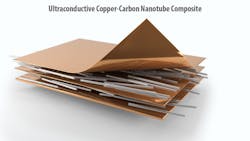Scientists investigating ways to improve electric vehicle adoption have developed a conductive material that outperforms copper alone. The new composite holds resonance for electric vehicle traction motors and power electronics.
The Oak Ridge National Laboratory (ORNL) researchers deposited and aligned carbon nanotubes (CNTs) on flat copper substrates to produce a metal-matrix composite material with current-handling capacity and mechanical properties.
Using a method known as electrospinning, the researchers deposited single-wall CNTs, which creates fibers as a jet of liquid speeds through an electric field. Kai Li, a postdoctoral researcher in ORNL’s Chemical Sciences Division, explained that the technique provides control over the structure and orientation of deposited materials. The process allowed scientists to successfully orient the CNTs in one general direction to facilitate enhanced flow of electricity, he noted.
The researchers employed a vacuum coating technique known as magnetron sputtering to add thin layers of copper film on top of the CNT-coated copper tapes. The coated samples were galvanized to produce a highly conductive Cu-CNT network by forming a dense, uniform copper layer and to allow diffusion of copper into the CNT matrix.
Further experimentation resulted in a copper-carbon nanotube composite that was 10 centimeters long and four centimeters wide. The microstructural properties of the new material included the facility to reach 14% greater current capacity, and up to 20% improved mechanical properties relative to pure copper.
Reporting in ACS Applied Nano Materials, the scientists noted the composite material reached 14% greater current capacity, with up to 20% improved mechanical properties compared with pure copper.
“By embedding all the great properties of carbon nanotubes into a copper matrix, we are aiming for better mechanical strength, lighter weight and higher current capacity,” said Tolga Aytug, lead investigator for the project. “Then you get a better conductor with less power loss, which in turn increases the efficiency and performance of the device. Improved performance, for instance, means we can reduce volume and increase the power density in advanced motor systems.”
The performance characteristics of the composite material have implications for electric motors, but could also improve electrification in applications where efficiency, mass and size are a key metric. The technology should have commercial viability in designing advanced conductors for electrical systems and industrial applications, noted the scientists.
“Electric motors are basically a combination of metals—steel laminations and copper windings,” noted Burak Ozpineci, manager of the ORNL Electric Drive Technologies Program and leader of the Power Electronics and Electric Machinery group. “To meet DOE’s Vehicle Technologies Office’s 2025 electric vehicle targets and goals, we need to increase power density of the electric drive and reduce the volume of motors by eight times, and that means improving material properties.”

